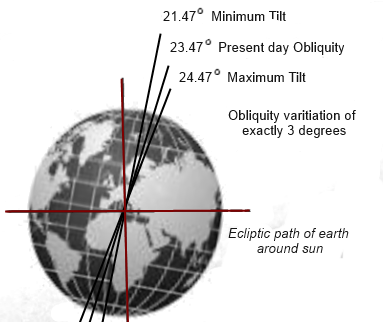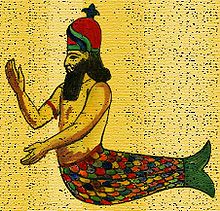End of the Age
Matthew 13 : The Parable of the Weeds Explained
36Then Jesus sent the multitude away, and went into the house: and his disciples came unto him, saying, Declare unto us the parable of the tares of the field. 37He answered and said unto them, He that soweth the good seed is the Son of man; 38The field is the world; the good seed are the children of the kingdom; but the tares are the children of the wicked one; 39The enemy that sowed them is the devil; the harvest is the end of the age; and the reapers are the angels. 40As therefore the tares are gathered and burned in the fire; so shall it be in the end of this age. 41The Son of man shall send forth his angels, and they shall gather out of his kingdom all things that offend, and them which do iniquity; 42And shall cast them into a furnace of fire: there shall be wailing and gnashing of teeth. 43Then shall the righteous shine forth as the sun in the kingdom of their Father. Who hath ears to hear, let him hear.
47Again, the kingdom of heaven is like unto a net, that was cast into the sea, and gathered of every kind: 48Which, when it was full, they drew to shore, and sat down, and gathered the good into vessels, but cast the bad away. 49So shall it be at the end of the age: the angels shall come forth, and sever the wicked from among the just, 50And shall cast them into the furnace of fire: there shall be wailing and gnashing of teeth.
1 Peter : A Living Hope
3Blessed be the God and Father of our Lord Jesus Christ, which according to his abundant mercy hath begotten us again unto a lively hope by the resurrection of Jesus Christ from the dead, 4To an inheritance incorruptible, and undefiled, and that fadeth not away, reserved in heaven for you, 5Who are kept by the power of God through faith unto salvation ready to be revealed in the last age.6Wherein ye greatly rejoice, though now for a season, if need be, ye are in heaviness through manifold temptations: 7That the trial of your faith, being much more precious than of gold that perisheth, though it be tried with fire, might be found unto praise and honour and glory at the appearing of Jesus Christ: 8Whom having not seen, ye love; in whom, though now ye see him not, yet believing, ye rejoice with joy unspeakable and full of glory: 9Receiving the end of your faith, even the salvation of your souls.
Daniel 12 : The Time of the End
1“Now at that time Michael, the great prince who stands guard over the sons of your people, will arise. And there will be a time of distress such as never occurred since there was a nation until that time; and at that time your people, everyone who is found written in the book, will be rescued. 2“Many of those who sleep in the dust of the ground will awake, these to everlasting life, but the others to disgrace and everlasting contempt. 3“Those who have insight will shine brightly like the brightness of the expanse of heaven, and those who lead the many to righteousness, like the stars forever and ever. 4“But as for you, Daniel, conceal these words and seal up the book until the end of time; many will go back and forth, and knowledge will increase.” 5Then I, Daniel, looked and behold, two others were standing, one on this bank of the river and the other on that bank of the river. 6And one said to the man dressed in linen, who was above the waters of the river, “How long will it be until the end of these wonders?” 7I heard the man dressed in linen, who was above the waters of the river, as he raised his right hand and his left toward heaven, and swore by Him who lives forever that it would be for a time, times, and half atime; and as soon as they finish shattering the power of the holy people, all these events will be completed. 8As for me, I heard but could not understand; so I said, “My lord, what will be the outcome of these events?” 9He said, “Go your way, Daniel, for these words are concealed and sealed up until the end time. 10“Many will be purged, purified and refined, but the wicked will act wickedly; and none of the wicked will understand, but those who have insight will understand.11“From the time that the regular sacrifice is abolished and the abomination of desolation is set up, there will be 1,290 days.12“How blessed is he who keeps waiting and attains to the 1,335 days! 13“But as for you, go your way to the end; then you will enter into rest and rise again for your allotted portion at the end of the age.”
Procession of the Equinox (Platonic Year )
Plato lends his name to the major cyclical movement of the sky called the Platonic Year, or “Procession of the Equinox”.
At the present time the North Pole points to the star Polaris in the constellation Ursa Minor.
12,000 years ago the North Star was Vega in the constellation Lyra.
6,000 years ago the North Star was Thuban in Draco.
The pole of the earth is inclined off perpendicular 23.4 degrees, tracing a very slow circle in the heavens.
Because of this arrangement of the “pole star” and the positions of the constellations relative to the seasons constantly move.
The constellations of the zodiac move with respect to the occurrence of the spring equinox, but only by one degree in 72 years.
The time of the spring and fall equinox moves continually through the constellations;
1 complete procession of the equinox is known as the “Platonic Year,” occurring every 25,920 years.
Priests and astrologers of antiquity carefully guarded the secret of the most important heavenly cycles;
Beyond the knowledge of the skies that could be learned through a lifetime of observation, there was a secret knowledge of the heavens that could not be documented unless preserved and handed down through generations.
Though visible in the heavens for nearly 1000 years, the mechanism of this cycle caused its appearance to be manifest at 6480 years intervals.
This cycle has been alluded to in myth in various guises, such as “the island that wanders through time and space.”
The Greek’s referred to this greatest heavenly cycle as an AION.
AION ::: AGE ::: Suntelia
The Greeks defined this cycle of an AION as the cosmic period between the creation and destruction of an age.

Ouroboros
They used a symbol-the Ouroboros.
The concept for the rise and fall of history between the cataclysmic destruction of one age and the rebuilding of cities and the foundation of new civilizations.
The Greek Ouranos (father of heaven) shared many traits with the Egyptian primordial snake god Urounus.
Interestingly, the name share the Chaldean root Ur (fire), and both deities are connected to the idea of the earliest times in earth’s history.
The root of the Greek Ouranos is related to Ourea meaning “to make water”.
and to the Hebrew root Or meaning, “to be or become light”.
Ur and Or have connotations of both water and light, and association with time-the dawn, the coming of the light.
The symbol of the ouroboros embodies the concepts of a serpent of light, a serpent from the dawn of time, a serpent of heaven, a fiery serpent that is also a sea serpent.
The “lifespan” of the ages is appropriately depicted as the Ouroborus, the serpent of light living in the heavenly river of the Milky Way.
Uerounus is depicted in the Egyptian stone zodiac of Dendera as the primordial serpent with his tail in his mouth, encircling Harpocrates (Young Horus) poised on top of the scales of Libra.
In the Egyptian papyrus of Dama Heroub, the young Egyptian god Horus is surrounded by the Ouroboros resting on top of the dual-headed lion, Routi, the god of future and the past….also Janus.
In Greek myth the Milky Way was deified as Oceanos, the celestial river that flowed in a circle around the earth.
This celestial river deity was associated with the early Greek titan Opohion (Native Serpent).
Oceanos is called the oldest of the Titans, an orphic god who ruled the world with this mother Eurynome, before the reign of Chronos. Oceanos was also, according to the ancient Greeks, the inventor of the arts and magic, and later associated with Poseidon.
Homer’s Iliad refers to Poseidon as “He who circles the earth” and “earth shaker”.
Poseidon ruled not only the waters of earth but also the waters of heaven.
The Milky Way was especially connected to him.
The Greeks considered Poseidon responsible for earthquakes because he “held up the earth in his celestial waters.”
‘The Phonenicians have represented it in their temples as a dragon curled in a circle and devouring it tail, to denote the way in which the world feeds on itself and returns on itself. (Macrobius Saturnalia).
According to ancient Hebrew esoterism Leviathan represents cyclic tiem as the great serpent of the waters of the galaxy.
Leviathan is also associated with the various forces in the heavens manifested by electricity in lightning or thunderbolts.
Who can open the doors of his face? (Job 41:9-14)
The clothing of the high priest of Israel was designed to represent the heavens and the Leviathan.
The Apocryphal Acts of Thomas characterized Leviathan as a dragon who lives beyond “the waters of the Abyss”.
This is the serpent that led astray through passions the angels from on high; this is the serpent that lead astray the first Adam and expelled him from Paradise.
The fiery serpent of light in the milky sea.

Nimrod : Osiris shooting arrow through serpents mouth. Rise of the Phoenix
Sagittarius resides on one of the two place the Milky Way intersects the ecliptic, the circuit of the heavens across the signs of the zodiac traveled by the sun and planets in their orbits as viewed from the earth.
The ecliptic, the path of the planets, crosses the Milky Way between Gemini and Taurus, and between Sagittarius and Scorpio, with the two most prominent signs on the ecliptic being Sagittarius and Gemini.
The arrow of Sagittarius delineates the union of the serpent’s head and tail; the celestial archer indicates the proper place to “Divide the Ouroborus”.
While the sun “rises in Sagittarius” and emerges from the serpents mouth yearly, the demarcation of the beginning and ending of the cosmic cycle of an aion occurs every 1/4th of a platonic year of 25,920 years.
The sign of the passing away of one aion and the beginning of the next “life span” occurs only when the sun rises in the outh of Ouroboros during a solstice or an equinox.
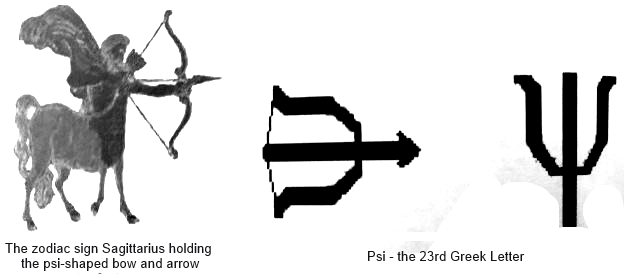
When the sun rises in the mouth of the Ouroboros, it is necessarily in the sign of Sagittarius, during one of the four “cardinal points” of the year.
“The primordial island, mountain or mound” rising form an “ocean of stars”.
The entire Milky Way surrounds the horizon in 360 degrees, creating the illusion of the earth as an island in the midst of the milky sea.
This illusion of the earth embraced by the Ourobros during these quarterly processional alignments is visible for about 1000 years, but occurs only for that relatively short period of time every 6480 years.
On the morning of the summer solstice, June 21st 12960 years ago, the sun appeared to rise out of the mouth of the Ouroboros with Sagittarius looking on This “sign in the heavens” was visible to the ancient culture flourishing on the earth 6480 years ago, occurring at that time during the equinox, September 21st.
The time is now that the Ouroboruos is again encircling he earth; the arrow of Sagittarius points to the rising sun in the mouth of the ouroborus on the morning of the winter solstice.
The time cycle of the Aion-divided at the mount of the Ouroborus-will have taken place 5 times during he course of one Platonic year of 25,920 years.
The Greeks called the conjuction of these ages the Sunteleia, marking the end of of one age and the beginning of another.
After usurping the powers of the previous deities:
Okeanos, Ouranos, Chronus (all manifestation of the ouroborus)
Poseidon in turn became the deified representation of the Milky Way
The aion-Poseidon was frequently depicted in the art of the Greeks with a “trident” which is the symbol of the 23rd Greek
Letter Psi.
The earth orbits the sun tilted at an angle of , on average 23 degrees.
Because the earth’s axis of rotation is not perpendicular to its plane of orbit, the earth receives more sunlight in one hemisphere and less in the other alternating every 6 months.
This variation of sunlight of the earth’s hemispheres causes the seasons to change.
During one Platonic year the earth’s obliquity will vary by only +or- 1.8 degrees between the 3 degree range of 21.5 and 24.5.
The earth’s current angle of obliquity is 23.5 Poseidon, the “Earth Embracer,” was aptly associated with the 23rd letter-the axis of the earth he embraced was tilted 23-degrees during the age of the Greeks, providing the celestial mechansism that made the Ouroboral alignment possible.
The 23 degree tilt of the earth causes the death and birth of season, and the death and birth of aions.
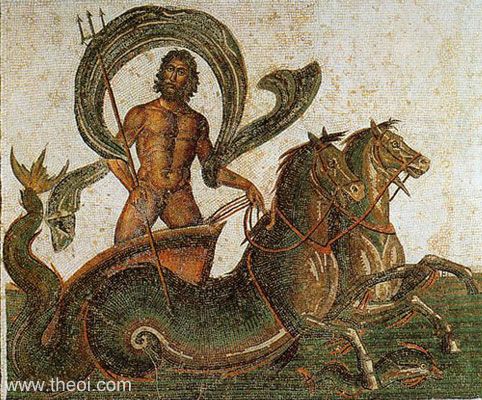
Poseidon
Poseidon was literally a Sidonian god.
The myth of the trident-baring Poseidon, the god who encircled earth as a serpent and presided over the birth and death of the ages, had a counterpart in the apple-man
Apollo, the god of the tripod and divination of the future, embodiment of the serpent at the omphalos of the earth.
Shiva is another intriguing deity wielding the trident and associated with “fire” and “red”.
The symbols of Shiva are the cobra, trident, and phallus, and he is often pictured as a dancer clothed in red.
The Ramayana describes the time when the Ganges River existed only in the heavens.
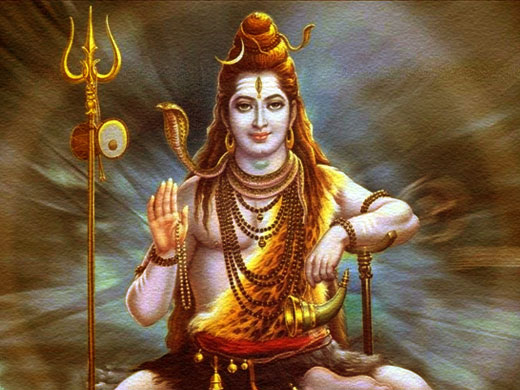
Shiva
Shiva assisted the descent of the celestial river, bringing it down from the heavens to the earth in his serpentine hair.
Shiva had a “son”, the two natured hybrid Ganesh, the god of doorways and beginnings.
Shiva is associated with the “destruction of the old to make room for the new.”
The word Shiva is an Indo-European root meaning “seven”.
From the Puranas we learn that Vishnu descends from heaven and is incarnated among men as an avatar, when the “end of an Age” occurs and “time has lost its strength.”
As the Mastya Avatar, Vishnu became a fish who warned King Manu of the impeding Global Flood.
Vishnu instructed Manu to gather the Seven Sages, animals and seeds, and to board a huge boat which he then tied to his body using the royal serpent Vasuki, taking the passengers to Mt. Himavan in order to survive the cataclysm in the next aion.
Dagan appears frequently in the Assyrian records from earlier dates in place of UanaAdap or Oannes.
The constellation Pisces the fishes is called in Hebrew Dagim.
The earliest records of the Hebrews in the time of the judges of Israel describe a Canaanite and Philistine fish-go called Dagon.
Samson is often depicted wearing is lion’s pelt as he destroys the pillars of Dagon, an image virtually identical to the avatar of Vishnu called Narashimha.
Vishnu as Narasimha- half lion, half man- emerges from a broken pillar, during evening time, neither night nor day.
A popular depiction of Vishnu resting atop the sleeping serpent is reminiscent of the ouroboros itself, encircling the youthful time-god Horus(hours) resting on top of the dual-headed Routi, lion-god of the future and past in Egyptian Myth.
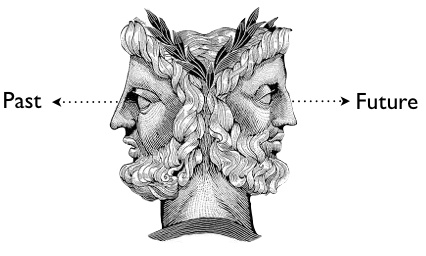
Janus
Janus, the two-headed Roman god who presides over doorways and arches, the dualistic god of war and peace, the past and future, after whom the month of January was named.
These deities associated with entryways, arches, pillars and doorways are also “time gods”- their dualistic nature to a transitional place and time, or a place of endings and new beginnings.
Dual-aspect gods commemorate in myth that the transitional period in time described in Plato’s Timaeus, when the former age passes away and the new age begins.
The hybrid deities of myth associated with pillars and entryways allude to the four cardinal points in the zodiac as the vernal equinox proceeds through the Great year of Plato.
The Ouroborus (Leviathan) is the connection that binds the creatures of the zodiac together.
The whole world, as well as the “Great Sea” which compasses it, rests on four pillars and these pillars rest on one of the fins of Leviathan.
During the course of the Great Year, four distinct zodiacal “ages” will have seen the sign of the Suntenalia (the fifth age is the same as the first, in a complete Platonic Year).
The cardinal points of the zodiac are the four signs of the previous Suntelias: Taurus, Leo, Scorpio, Aquarius
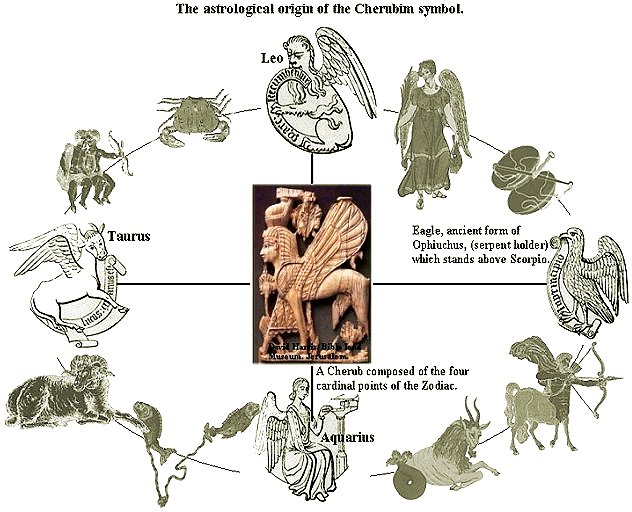
The four creatures of these constellations comprise the hybrid gods of myth, and commemorate those cataclysmic times of transition between the aions.
Plato describes the cardinal points of the zodiac-the “four pillars”-forming a cross in the circle of the heavens:
This entire compound he divided length ways into two parts, which he joined to one another at the center like the letter X, and bent them into a circular form, connecting them with themselves and each other at the point opposite to their original meeting-point; and, comprehending them in a uniform revolution upon the same axis, he made the one the outer and the other the inner circle.
In antiquity the four cardinal points of the heavens were symbolically portrayed as a creature called a cherubim.
This creature was considered not only a reference to the mechanics of the heavans but also a representation of the deities inhabiting the celestial realm.
Similar Akkadian or Assyrian beings karibu (one who intercedes) were arbitrators who presented the prayers of earthly men to the gods in the heavens.
In the OT, cherubim were described as the foundation of the throne of God, and these beings were depicted on the Ark of the Covenant and Solomon’s Temple in Jerusalem.
Two cherubim supported the throne of the Sidonian King Hiram.
Winged Lions with Human Heads.
They were placed at the gateway to the Garden of Eden, to guard the tree of the fruit of eternal life.
Cherubim were beings whose physical appearance reflected their duty of messenger between heavens and earth, hybrid creatures embodying a celestial union.
While the cherubim referred to the four cardinal zodiacal signs of the year in which the sunteleia sign of the changing aion had occurred, more significant was the hybrid sphinx, which signified the transitional zodiacal ages of the sunteleia.
The symbol of the sphinx-from the Greek root meaning “to bind together”-is a hybrid creature combining the constellation Leo and Virgo.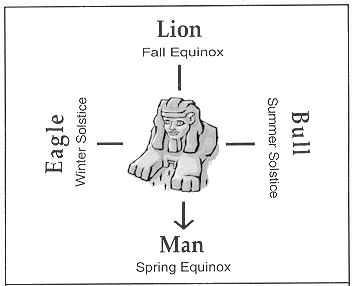
Images of the mythical sphinx were placed at entryways to temples, and at the thresholds of doorways.
The most common depiction of the sphinx is the creature posing the riddle to Oedipus: the subject of the sphinx’s riddle-the life span of mankind-dicloses the link between the sphinx and the ouroborus, symbol of the aion.
The sign of the suntelia of 10948 BC occurred while the Milky Way aligned with the horizon of the earth, and the sun rose in the mouth of the ouroborus during the Autumn Equinox, Sept 21st-during the age between Leo and Virgo.
It was during that transition from the age of Virgo to Leo, embodied by the sphinx, that the Great Flood of legend occurred.
The Egyptians and the Sumerians described the first land after the deluge as a primordial mound that rose out of the cosmic sea.
The time referred to in myth as the Flood was the time demarked by the Ouroboral cosmic clock.
The cosmic waters aligned to surround the earth while at the same time the world was actually destroyed by a flood; this heavenly portent and the earth’s destruction by water occurred at the same time.

